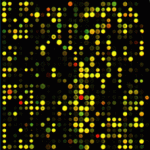Genomics
|
14 may 2012 11:33:00 |
| Estimating RNA-quality using GeneChip microarrays (BMC Genomics) |
|
Tweet Background:
Microarrays are a powerful tool for transcriptome analysis. Best results are obtained using high-quality RNA samples for preparation and hybridization. Issues with RNA integrity can lead to low data quality and failure of the microarray experiment.
Results:
Microarray intensity data contains information to estimate the RNA quality of the sample. We here study the interplay of the characteristics of RNA surface hybridization with the effects of partly truncated transcripts on probe intensity. The 3`/5` intensity gradient, the basis of microarray RNA quality measures, is shown to depend on the degree of competitive binding of specific and of non-specific targets to a particular probe, on the degree of saturation of the probes with bound transcripts and on the distance of the probe from the 3`-end of the transcript. Increasing degrees of non-specific hybridization or of saturation reduce the 3`/5` intensity gradient and if not taken into account, this leads to biased results in common quality measures for GeneChip arrays such as affyslope or the control probe intensity ratio. We also found that short probe sets near the 3`-end of the transcripts are prone to non-specific hybridization presumable because of inaccurate positional assignment and the existence of transcript isoforms with variable 3` UTR`s . Poor RNA quality is associated with a decreased amount of RNA material hybridized on the array paralleled by a decreased total signal level. Additionally, it causes a gene-specific loss of signal due to the positional bias of transcript abundance which requires an individual, gene-specific correction. We propose a new RNA quality measure that considers the hybridization mode. Graphical characteristics are introduced allowing assessment of RNA quality of each single array (`tongs plot` and `degradation hook`). Furthermore, we suggest a method to correct for effects of RNA degradation on microarray intensities.
Conclusions:
The presented RNA degradation measure has best correlation with the independent RNA integrity measure RIN, and therefore presents itself as a valuable tool for quality control and even for the study of RNA degradation. When RNA degradation effects are detected in microarray experiments, a correction of the induced bias in probe intensities is advised. |
| 107 viewsCategory: Genomics |
 The dependence of expression of NF-kappaB-dependent genes: statistics and evolutionary conservation of control sequences in the promoter and in the 3` UTR (BMC Genomics) The dependence of expression of NF-kappaB-dependent genes: statistics and evolutionary conservation of control sequences in the promoter and in the 3` UTR (BMC Genomics)Genetic and genome-wide transcriptomic analyses identify co-regulation of oxidative response and hormone transcript abundance with vitamin c content in tomato fruit (BMC Genomics) 
|
| blog comments powered by Disqus |
MyJournals.org
The latest issues of all your favorite science journals on one page
The latest issues of all your favorite science journals on one page



